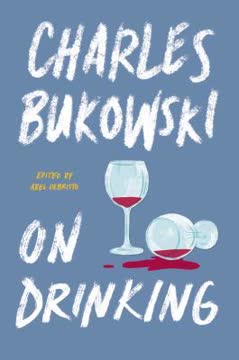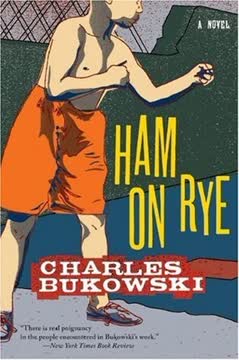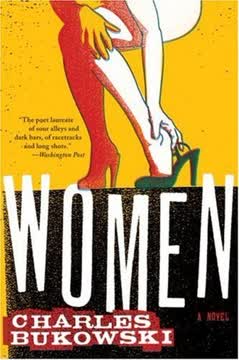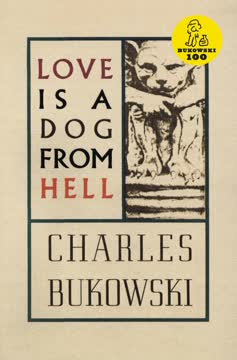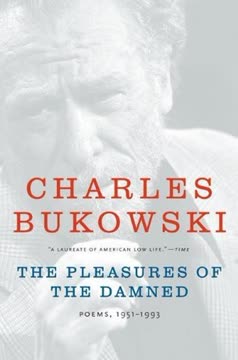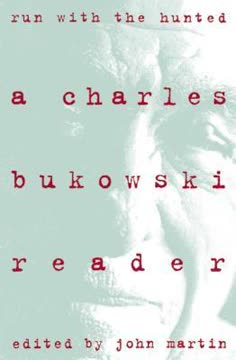Plot Summary
The Drunken Muse
Charles Bukowski's life and work are deeply intertwined with his drinking habits. He finds inspiration and solace in alcohol, which fuels his writing and provides an escape from the mundanity of life. His poetry and prose often reflect the raw, unfiltered experiences of a man who embraces the chaos and unpredictability that come with heavy drinking. Bukowski's candid portrayal of his struggles with alcohol reveals a complex relationship where the bottle serves as both a muse and a crutch, allowing him to explore the depths of human emotion and the gritty realities of existence.
A Life of Excess
Bukowski's life is marked by excess, from his relentless drinking to his tumultuous relationships. He navigates the world of bars and cheap motels, finding camaraderie among fellow drunks and misfits. His stories are filled with vivid characters and wild escapades, painting a picture of a man who lives on the edge, unafraid to confront the darker aspects of life. Despite the chaos, Bukowski's writing captures moments of beauty and truth, offering a glimpse into the mind of a man who refuses to conform to societal norms.
The Poet's Struggle
Bukowski's journey as a writer is fraught with challenges, from financial instability to self-doubt. He grapples with the pressures of the literary world, often feeling like an outsider. Yet, his perseverance and unique voice set him apart, earning him a dedicated following. Through his work, Bukowski explores themes of alienation, creativity, and the human condition, using his personal experiences as a lens to examine the world around him. His raw, unapologetic style resonates with readers who appreciate his honesty and vulnerability.
Love and Loneliness
Bukowski's relationships with women are as tumultuous as his relationship with alcohol. He writes candidly about love, lust, and heartbreak, often portraying himself as a flawed and conflicted lover. His interactions with women are marked by passion and volatility, reflecting his struggle to find connection and meaning in a world that often feels indifferent. Despite the chaos, Bukowski's writing reveals a deep longing for intimacy and understanding, capturing the complexities of human relationships with brutal honesty.
The Barfly's World
Bukowski's world is populated by drunks, gamblers, and outcasts, people who live on the fringes of society. He finds a sense of belonging among these misfits, who share his disdain for conventional life. His writing paints a vivid picture of the bar scene, where stories are exchanged over drinks and the line between reality and illusion blurs. Through his characters, Bukowski explores themes of survival, resilience, and the search for meaning in a world that often seems hostile and unforgiving.
Redemption and Reflection
As Bukowski ages, he begins to reflect on his life and the choices he has made. He grapples with the consequences of his drinking and the toll it has taken on his body and relationships. Despite his struggles, Bukowski finds moments of clarity and redemption, often through his writing. His later work reveals a more introspective and contemplative side, as he seeks to make sense of his past and find peace in the present. Through his reflections, Bukowski offers insights into the human condition and the possibility of change and growth.
The Final Toast
Bukowski's work continues to resonate with readers long after his death, cementing his status as a literary icon. His unflinching honesty and unique voice have inspired countless writers and artists, and his influence can be seen in various forms of media. Despite his flaws, Bukowski's legacy is one of resilience and authenticity, a testament to the power of art to capture the complexities of the human experience. As readers raise a glass to Bukowski, they celebrate a life lived on one's own terms and the enduring impact of his work.
Characters
Charles Bukowski
Bukowski is the central figure in his own narrative, a man who embraces his vices and uses them as fuel for his art. His writing is deeply personal, reflecting his struggles with alcohol, relationships, and the search for meaning. Bukowski's raw honesty and unique voice set him apart as a literary icon, capturing the complexities of the human experience with unflinching candor.
The Women
The women in Bukowski's life are both sources of inspiration and conflict. His relationships are marked by passion and volatility, reflecting his struggle to find connection and meaning. Despite the chaos, these women play a crucial role in Bukowski's life and work, serving as muses and catalysts for his creative expression.
The Barflies
Bukowski's world is populated by fellow drunks and misfits, people who share his disdain for conventional life. These characters provide a sense of camaraderie and belonging, offering a glimpse into the gritty realities of life on the fringes of society. Through their stories, Bukowski explores themes of survival, resilience, and the search for meaning.
The Critics
Throughout his career, Bukowski faces criticism and skepticism from the literary establishment. These voices challenge his unconventional style and subject matter, often dismissing his work as crude or unrefined. Despite this, Bukowski remains true to his vision, using the criticism as motivation to continue writing and pushing boundaries.
The Father
Bukowski's relationship with his father is fraught with tension and resentment. His father's disapproval and harsh treatment leave a lasting impact on Bukowski, fueling his desire to rebel against authority and societal norms. This complex relationship is a recurring theme in Bukowski's work, shaping his worldview and artistic expression.
Plot Devices
Alcohol as a Muse
Alcohol plays a central role in Bukowski's life and work, serving as both a source of inspiration and a destructive force. It allows him to explore the depths of human emotion and the gritty realities of existence, while also providing an escape from the mundanity of life. This duality is a recurring theme in Bukowski's writing, reflecting his complex relationship with the bottle.
The Outsider Perspective
Bukowski often positions himself as an outsider, observing the world from the fringes of society. This perspective allows him to explore themes of alienation, creativity, and the human condition with a unique voice and raw honesty. Through his writing, Bukowski offers insights into the complexities of life and the search for meaning in a world that often feels indifferent.
Raw Honesty
Bukowski's writing is characterized by its unflinching honesty and candid portrayal of his experiences. He refuses to shy away from the darker aspects of life, using his personal struggles as a lens to examine the world around him. This raw, unapologetic style resonates with readers who appreciate his authenticity and vulnerability.
Analysis
"On Drinking" by Charles Bukowski is a testament to the power of art to capture the complexities of the human experience. Through his candid portrayal of his struggles with alcohol and relationships, Bukowski offers insights into the darker aspects of life and the search for meaning. His raw honesty and unique voice have inspired countless writers and artists, cementing his status as a literary icon. Despite his flaws, Bukowski's legacy is one of resilience and authenticity, a celebration of a life lived on one's own terms. His work continues to resonate with readers, offering a glimpse into the mind of a man who refused to conform to societal norms and embraced the chaos and unpredictability of life.
Last updated:
FAQ
Synopsis & Basic Details
What is On Drinking about?
- A Raw Exploration of Addiction: "On Drinking" is a collection of poems, letters, and prose excerpts by Charles Bukowski that delves into his lifelong, complex relationship with alcohol. It's not a linear narrative but a mosaic of experiences, reflections, and philosophical musings on drinking as a way of life, a creative fuel, and a path to self-discovery and destruction.
- Life Through a Bottle: The book chronicles Bukowski's existence from his early days of destitution and bar-fighting to his later years of literary success, always with alcohol as a muse as a central, defining element. It explores how drinking shaped his relationships, his writing, his perceptions of society, and his very identity, offering an unfiltered look at the "barfly's world."
- Beyond the Surface of Vice: While unflinchingly honest about the physical and social consequences of heavy drinking, the collection also probes deeper, presenting alcohol as a means of rebellion, a source of temporary transcendence, and a lens through which to view the absurdities and hypocrisies of the human condition.
Why should I read On Drinking?
- Unfiltered Authenticity: Readers should engage with "On Drinking" for its raw honesty, unapologetic voice that cuts through pretense and societal norms. Bukowski's prose and poetry offer a rare, honest glimpse into a life lived on the fringes, providing a powerful counter-narrative to conventional success stories.
- Deep Dive into the Human Condition: Beyond the drinking, the collection explores universal themes of alienation, creativity, love, loneliness, and the search for meaning. Bukowski uses his personal struggles as a lens to examine the broader human experience, making his work resonate with those who feel like outsiders.
- Literary Craft and Defiance: For aspiring writers and literary enthusiasts, "On Drinking" showcases Bukowski's distinctive style—direct, visceral, and often darkly humorous. It demonstrates how a writer can transform personal chaos into compelling art, challenging traditional notions of what constitutes "literature" and "inspiration."
What is the background of On Drinking?
- Autobiographical Fragments: The collection draws heavily from Charles Bukowski's own life, including his German birth, difficult Los Angeles upbringing, and decades spent as a postal worker and struggling writer. Many pieces are direct excerpts from his letters and interviews, offering a candid, first-person account of his experiences.
- Post-War American Underbelly: The settings often reflect the gritty, working-class environments of mid-20th century America—skid row hotels, dive bars in Philadelphia and Los Angeles, and charity hospitals. This backdrop highlights the social and economic struggles that often accompanied Bukowski's drinking and writing.
- A Life of Constant Struggle: Bukowski's background is marked by poverty, physical ailments (like severe acne and boils in youth, later hemorrhages from drinking), and a contentious relationship with his father. These early hardships deeply influenced his cynical worldview and his embrace of alcohol as both a coping mechanism and a defiant act against a world he found unbearable.
What are the most memorable quotes in On Drinking?
- "Drinking is a temporary form of suicide wherein I am allowed to kill myself and then return to life again.": This quote from a letter to Douglas Blazek encapsulates Bukowski's complex view of alcohol as both a destructive force and a cyclical rebirth, highlighting the psychological depth of his addiction. It's a key insight into Bukowski's motivations explained.
- "I'm a genius and nobody knows it but me!": Screamed in "40 years ago in that hotel room," this line reveals the profound isolation and self-belief that fueled his artistic drive, even in the depths of drunken despair. It speaks to the themes in On Drinking of unrecognized talent and defiant ego.
- "I have drunk more than the first one hundred men you will pass on the street or see in the madhouse. I scratch my belly and dream of the albatross.": From "tonight," this powerful statement asserts his unique, almost mythical status as a drinker, while the image of the albatross symbolizes a heavy, inescapable burden or a strange, solitary grace. This quote is central to On Drinking symbolism and his self-perception.
What writing style, narrative choices, and literary techniques does Charles Bukowski use?
- Raw Honesty, Conversational Prose: Bukowski employs a direct, unadorned, and often colloquial style that mimics spoken language, making his narratives feel immediate and intimate. This choice creates a sense of authenticity, as if the reader is listening to a friend recount a story, as seen in his letters and interview excerpts.
- First-Person, Autobiographical Perspective: The majority of the collection is told from Bukowski's (or his alter-ego Henry Chinaski's) first-person point of view, blurring the lines between author and character. This narrative choice immerses the reader directly into his subjective experiences, thoughts, and emotional states, emphasizing his "outsider perspective" and personal struggles.
- Repetition and Juxtaposition: He frequently uses repetition of phrases, images, and themes (e.g., "drinking," "typewriter," "women") to create a rhythmic, almost incantatory effect, reinforcing his obsessions. He also masterfully juxtaposes the mundane with the profound, the vulgar with the poetic, and moments of despair with flashes of dark humor, as exemplified in poems like "ants crawl my drunken arms" where classical artists are placed alongside Willie Mays.
Hidden Details & Subtle Connections
What are some minor details that add significant meaning?
- The "Act of Art" at Dick's Liquor Store: In the letter to Jon and Louise Webb, Bukowski's elaborate charade of feigned anger and indignation to secure liquor on credit is a minor detail that reveals his performative nature and cunning survival instinct. This "act" is a microcosm of his larger artistic process, where he transforms desperation into a kind of defiant, self-aware performance, blurring the lines between life and art.
- The Zen Master's "Thinnest Ears": During "The Great Zen Wedding," Bukowski's drunken fixation on the Zen master's unusually thin ears, perceiving them as a mark of holiness, is a subtle detail that highlights his rejection of conventional spiritual authority. Instead of finding profundity in the ceremony, his intoxicated mind latches onto a bizarre physical trait, symbolizing his search for meaning in the tangible and often grotesque, rather than the abstract or revered.
- The Unbroken Glass Coffee Table: In "speaking of drinking...", Bukowski recounts crashing onto a glass coffee table, crushing its legs, yet the "thin glass top was down there unbroken." This seemingly throwaway detail serves as a powerful metaphor for his own resilience and improbable survival despite a life of self-destruction. It suggests a paradoxical strength, where the fragile (glass, his body) endures while the structural supports (table legs, societal norms) collapse around him.
What are some subtle foreshadowing and callbacks?
- Early Boils to Later Hemorrhage: In his letter to John William Corrington, Bukowski details his childhood suffering from "HUGE boils." This early physical torment subtly foreshadows the later, life-threatening hemorrhage he experiences from drinking, described in "Confessions of a Man Insane Enough to Live with Beasts." This pattern suggests a lifelong struggle with his body, where early afflictions evolve into self-inflicted wounds, linking his physical pain to his chosen path.
- The "Escapism" Debate: The recurring argument with women about drinking being "only escapism" (e.g., in a March 1, 1964 letter and "From Women") acts as a thematic callback throughout the collection. Each time, Bukowski defiantly refutes the notion, asserting that sex, eating, and even breathing are forms of escapism. This repeated dialogue underscores his rejection of simplistic psychological labels and his insistence on a more complex, all-encompassing view of human existence and Bukowski's motivations.
- The "Genius" Declaration: The drunken scream, "I'M A GENIUS AND NOBODY KNOWS IT BUT ME!" in "40 years ago in that hotel room," is a powerful callback to his earlier, unacknowledged struggles as a writer. This private, defiant declaration, made to a sneering Jane and a desk clerk, foreshadows his eventual, albeit unconventional, literary recognition, highlighting the long, lonely road to self-validation that precedes public acclaim.
Who are the most significant supporting characters?
- Jane (Lydia/Barbara): Often appearing under different names, Jane is a recurring, volatile female companion who embodies the chaotic and destructive aspects of Bukowski's romantic life. Her own alcoholism and fierce independence ("some picnic," "40 years ago in that hotel room," "From Women") mirror his own, making her a significant figure who challenges and reflects his self-destructive tendencies, providing a raw look at relationship dynamics.
- Dick (the liquor store owner): Though a minor character, Dick represents the transactional, yet strangely enduring, relationships Bukowski forms out of necessity. His willingness to extend credit, despite Bukowski's unreliable payments, highlights a subtle understanding or resignation to the "barfly's world," making him a symbol of the informal economy and moral flexibility that sustained Bukowski's lifestyle.
- The Landlord and Landlady: Featured in "my landlady and my landlord" and a letter to A.D. Winans, this couple offers a rare glimpse of stable, albeit eccentric, acceptance in Bukowski's life. Their shared drinking sessions and tolerance of his "crazy" behavior provide a contrast to his often-strained family relationships, suggesting a found family among fellow outsiders and a different kind of character connection.
Psychological, Emotional, & Relational Analysis
What are some unspoken motivations of the characters?
- Bukowski's Quest for Authentic Experience: Beneath the drinking and debauchery, Bukowski is driven by an unspoken motivation to live an unvarnished, "real" life, rejecting the perceived phoniness of mainstream society. His constant pursuit of extreme experiences, whether through alcohol, fights, or transient relationships, is an attempt to feel truly alive and to gather material for his writing, as hinted in "Paying for Horses" where he states drinking and shacking became his "art form."
- The Women's Desire for Transformation: Many women in Bukowski's life, like the editor who asks "WHY DID THE CENTRAL CHARACTER BEGIN TO DRINK IN THE FIRST PLACE?" or those who try to "mother" him, are implicitly motivated by a desire to "save" or transform him. This unspoken hope for change often clashes with Bukowski's entrenched identity, leading to the volatile relationship dynamics explored throughout the collection.
- The "Barflies'" Search for Belonging: The various drunks and outcasts Bukowski encounters are often silently motivated by a profound loneliness and a need for acceptance, finding a temporary community in the shared ritual of drinking. Their camaraderie, though often superficial or fleeting, provides a sense of belonging that is absent in their lives outside the bar, as seen in "short non-moon shots to nowhere" where he finds more "light" in the eyes of "imbecile winos."
What psychological complexities do the characters exhibit?
- The Paradox of Self-Destructive Creation: Bukowski's most profound psychological complexity lies in his belief that alcohol as a muse, while physically destructive, is essential for his creative process. He views drinking as "anti-destructive" and a way to "loosen the air, put some gamble into the word" ("Tough Company"), suggesting a mind that thrives on chaos and finds clarity in intoxication, a key aspect of Bukowski's psychological analysis.
- Defiance as a Core Identity: His consistent refusal to conform, whether to societal expectations, literary conventions, or even medical advice, reveals a deep-seated psychological need for autonomy and rebellion. This defiance is not merely external but an internal compass, shaping his choices and his art, as evidenced by his dismissal of the doctor's warning, "One more drink will kill you," by taking "more than one more drink" ("hangovers").
- Vulnerability Masked by Aggression: Despite his tough-guy persona and frequent outbursts, Bukowski often reveals moments of profound vulnerability and sensitivity. His aggressive behavior, such as at "The Great Zen Wedding" or in bar fights, can be interpreted as a defense mechanism against a world he finds overwhelming and disappointing, a complex interplay of fear and bravado.
What are the major emotional turning points?
- The Near-Fatal Hemorrhage: The most significant emotional turning point is Bukowski's near-death experience from a hemorrhage, detailed in "Confessions of a Man Insane Enough to Live with Beasts" and "Paying for Horses." This event forces a temporary sobriety and a profound shift in perspective, leading him to feel "strangely relaxed" and reigniting his writing career, marking a pivotal moment in his character development.
- The Zen Wedding Debacle: The "Great Zen Wedding" serves as an emotional crucible, where Bukowski's anti-social tendencies reach a peak, culminating in his violent confrontation with the Zen master and his subsequent abandonment by Roy and Hollis. This experience solidifies his cynical view of human relationships and societal structures, leading to his realization of the "family-relationship illness" and deepening his sense of alienation.
- Jane's Tragic Death: The quiet, somber account of Jane's death from alcoholism in "Hollywood" is a poignant emotional turning point. Despite their tumultuous relationship, her passing, and his observation that "She was the only person I've ever met who had the same contempt for the human race as I did," reveals a deep, shared understanding and loss, highlighting the ultimate cost of their chosen lifestyle and the profound loneliness that often accompanies it.
How do relationship dynamics evolve?
- From Parental Conflict to Defiant Independence: Bukowski's early relationship with his father is characterized by intense conflict and disapproval, particularly regarding his drinking ("From Factotum"). This dynamic evolves into a fierce, defiant independence, where Bukowski actively rejects his parents' values and embraces his "drunkard" identity, shaping his worldview and artistic expression.
- Volatile Romantic Cycles: His romantic relationships, often with women like Jane (Lydia/Barbara), follow a cyclical pattern of intense passion, mutual destruction, and eventual separation. These dynamics are marked by extreme highs and lows, fueled by alcohol and a shared disregard for conventional stability, as seen in "From Women" and "40 years ago in that hotel room," where love and conflict are inextricably linked.
- Transient Barroom Camaraderie: The relationships formed in bars are typically transient and superficial, based on shared drinking and outsider status. While offering temporary solace and a sense of belonging, these connections rarely evolve into deep, lasting bonds, reflecting the inherent loneliness of his chosen path, as he notes in "the angels of Sunday," "I want to get drunk alone."
Interpretation & Debate
Which parts of the story remain ambiguous or open-ended?
- The True Source of His "Genius": Bukowski frequently attributes his writing prowess to alcohol, yet in later interviews ("Charles Bukowski," "Q&A"), he claims to write just as well sober. This leaves ambiguous whether alcohol was truly a muse or merely a crutch, or if his "genius" transcended the substance, inviting debate on the themes in On Drinking regarding creativity and addiction.
- The Nature of His "Love" for Women: Despite his often crude and transactional descriptions of women, Bukowski occasionally expresses profound, if fleeting, affection or longing (e.g., "god, how I love that woman!" in "in the name of love and art"). The true depth and sincerity of these emotions, given his volatile relationships, remain open to interpretation, challenging readers to reconcile his misogynistic tendencies with moments of tenderness.
- The Meaning of His "Albatross": In "tonight," Bukowski dreams of the albatross, a symbol often associated with a burdensome curse or a profound, solitary journey. The ambiguity lies in whether this albatross represents the weight of his drinking, his unique artistic path, or the inescapable human condition, leaving its ultimate On Drinking symbolism open to reader interpretation.
What are some debatable, controversial scenes or moments in On Drinking?
- The "Great Zen Wedding" Behavior: Bukowski's actions at the Zen wedding, including his vulgar propositions, the "handcrafted coffin" gift, and physical altercation with the Zen master, are highly controversial. This scene sparks debate about whether his behavior is a genuine expression of anti-establishment art, a drunken act of aggression, or a calculated performance designed to provoke and expose societal hypocrisy.
- Explicit Racism in Interviews: In "Charles Bukowski. Dialog with a Dirty Old Man," Bukowski explicitly states, "I'm antiblack, true. I'm antiyellow, antianything." This direct admission of racism is a deeply controversial moment, forcing readers to confront the problematic aspects of his persona and art, and to debate whether such views can be separated from the literary merit of his work.
- The Treatment of Women: Throughout the collection, Bukowski's portrayal of women and his interactions with them are often crude, objectifying, and violent (e.g., the fight with Laura Day in "Notes of a Dirty Old Man," the "fooling Marie" incident). These scenes provoke strong reactions and lead to ongoing debates about misogyny in his work, and whether his "raw honesty" justifies or merely reflects harmful attitudes.
On Drinking Ending Explained: How It Ends & What It Means
- A Defiant, Solitary Acceptance: The collection concludes not with redemption or sobriety, but with a defiant acceptance of his drinking life, particularly in "tonight." Bukowski acknowledges his "brain cells eaten away by alcohol" and his drinking partners "dead," yet he embraces his solitary path, stating, "I have been selected." This ending signifies that for Bukowski, drinking is not a failure but a chosen, almost sacred, way of existence, a key aspect of On Drinking ending explained.
- The Enduring Power of Art and Music: Despite the physical toll and social isolation, the final pieces emphasize the enduring importance of writing and classical music as his "stronghold" and "great luck in life" ("11/6/92 12:08 AM"). Even as he reflects on the "grimy" nature of humanity, these artistic pursuits provide meaning and a sense of belonging, suggesting that his creative spirit transcends his physical decline.
- A Cyclical, Not Conclusive, Journey: The ending avoids a definitive resolution, instead presenting life as a continuous cycle of drinking, writing, and reflection. His brief periods of sobriety or attempts to "dry out" are always temporary, reinforcing the idea that his identity is inextricably linked to his vices. The final lines of "tonight" – "and I am as young as the fire that burns now" – suggest an eternal, unquenchable spirit, forever engaged in the "mad river" of his life, offering a nuanced analysis of Bukowski's motivations and legacy.
Review Summary
On Drinking receives mixed reviews, with many praising Bukowski's raw honesty and unique writing style. Readers appreciate his unfiltered perspective on alcoholism and its impact on his life and work. Some find the book repetitive or triggering, while others view it as a powerful exploration of addiction and creativity. Critics note Bukowski's misogynistic tendencies but acknowledge his self-awareness. The collection includes poems, short stories, letters, and interviews, offering both longtime fans and newcomers insight into the author's complex relationship with alcohol.
Download PDF
Download EPUB
.epub digital book format is ideal for reading ebooks on phones, tablets, and e-readers.
